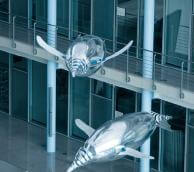
I have a new favorite robot. It’s called the AirPenguin and it’s exactly what it sounds like: a robotic penguin that flies. If that doesn’t get you to generate some nerdy exuberance then, brother, you need to turn in your slide rule and hang up your Spock ears. This thing is awesome, and it’s just one of the many creative robots that mimic real-world animals from Festo‘s Biological Learning Network. The BLN uses biology as inspiration for robotic innovation. Festo and their associates have harnessed nature’s design for everything from kite-flying to 3D printing. Watch BLN’s summary videos from the last two years below to see how biology has inspired some very exciting robots.
When robotics engineers are at a loss for how to accomplish a difficult task, mimicking biology (biomimetics) seems like their go-to backup plan. We’ve seen some really great robots that gain their inspiration from nature, including bots that run like a cockroach, fly like a hummingbird and scale walls like a gecko. By co-opting nature’s design, engineers take advantage of millions of years of evolutionary trouble-shooting and debugging. In some cases, copying biology is a short-cut – you can mimic a system without necessarily understanding all the reasons why it works. That’s a great stepping stone and one we’re likely to see more and more often as the field of robotics continues to advance. In the future, we may see useful robots in the shapes of animals as often as in the shapes of humans and household appliances.
To understand the BLN you have to imagine those individual biomimetic research projects and link them together through a joint commercial enterprise. Festo is an international robotics supplier and developer, and the Bionic Learning Network is really just an umbrella name for a series of partnerships with other developers like EvoLogics and Effekt-Technik. All this collaboration allows for companies with vision to be paired with companies with means (either of which may describe Festo in a particular case) and that leads to amazing robots.
Don’t miss the AirPenguin at 1:07!
In essence, Festo has happened on two great tools for advancing research in robotics: biomimicry and collaboration. Neither is new, but in tandem they’ve produced projects that are tantalizing in their possibilities. As excited as I am about robotic penguins (and I’m freakin’ crazy enthusiastic about them if you haven’t noticed) it’s the soft-touch arms that can interact in a human environment that may have more near term applications. As we build humanoid robots to do our bidding, we have to make sure that they won’t run hurt us in the process of executing their tasks. While that could be accomplished with quick sensors, precision movement, and reactive commands, having softer, more supple robots seems safer.
Copying biology doesn’t guarantee that a robot will outperform the standard industrial model. Festo’s flexible fin grippper and trunk-like arm can’t beat an ABB robot or Flexpicker in a speed test, nor do I think that the biology inspired 3D printer is going to be faster than current commercial models. The same goes for the modular robots, and even the wind-harnessing kite. Yes the Festo Biological Network has the potential to create some never before seen robots (penguins!) but it is likely to take years and many iterations of refining these projects before they are competitive. Just as it would with any other robotics developer.
Perhaps we should view the Bionic Learning Network as a sort of high level professional incubator for new biomimetic ideas. Most of these concepts aren’t likely to make a huge splash in the industry but taken together they represent a healthy exploration of the biomimicry paradigm that is likely to pay huge dividends at some point in the future. It’s a long term vision, but Festo seems to be well acquainted with long-term visions for robotics. They’re a regular (and substantial) sponsor for the FIRST Robotics Competition, after all. It should be interesting to see which of the BLN projects make the cut and how they are applied when they do.
Now, if you’ll excuse me, I’m going to have a very geeky daydream about riding a giant AirPenguin through a futuristic city full of animal robots. You’re welcome to join me.
[image and video credit: Festo]
[source: Festo]


